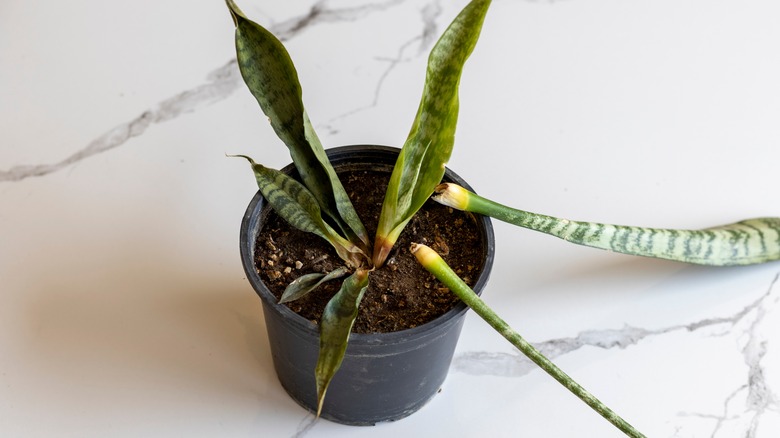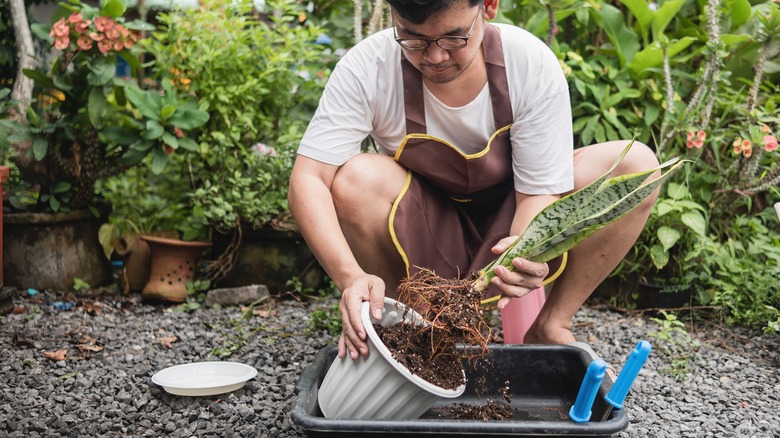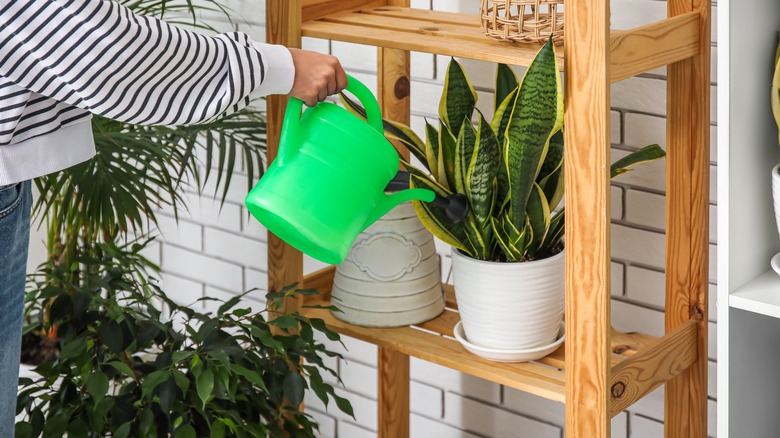Save An Overwatered Snake Plant From Root Rot With An Easy Hydrogen Peroxide Trick
Wilting leaves, mushy stems, and stinky soil are all signs that your snake plant is suffering from root rot. It's a common problem for this popular houseplant, and stems from overwatering or poor air circulation in the soil. Luckily, it can be solved with a common household product — hydrogen peroxide. In an exclusive House Digest interview, we spoke to Paris Lalicata, head of plant education and community at The Sill, to find out how hydrogen peroxide can save a snake plant suffering from root rot.
"Using hydrogen peroxide against root rot can effectively save the plant since it kills the fungi responsible for root rot and helps to add more oxygen around the roots," Lalicata explained. After the disease is eradicated, the succulent can be replanted and given a second chance at life. However, there needs to be at least some viable roots for this trick to work. "If all the roots of the snake plant as well as the leaves are showing signs of rot, there's a chance the plant cannot be saved," the expert added. But if there's at least one healthy leaf, there's still hope: You can propagate your snake plant and create new roots from the cutting. Lalicata also gave us some tips to prevent root rot in the first place, so you won't have to resort to this hydrogen peroxide trick in the future.
How to save snake plant from root rot with hydrogen peroxide
"It'll be best to treat the [plant] with the hydrogen peroxide solution directly to the roots once all the soil and dead/decaying roots are removed," Paris Lalicata exclusively told House Digest. To prep your snake plant, first, take it out of the pot, clear off any soil, rinse the roots with water, and cut any dying roots and leaves. Then, it's time for the hydrogen peroxide. "Generally, you can use 1 part 3% hydrogen peroxide to 2 parts water," she said. You can spray the roots or let them soak in the solution for a few minutes before air-drying. The hydrogen peroxide kills the fungus, while drying it eliminates the environment the bacteria needs to grow. After, you can replant the succulent with fresh potting mix. Make sure to disinfect the tools and pot you use for your revived snake plant to prevent the fungus from returning.
There are a few things to keep in mind with this method: "The main downside to using the hydrogen peroxide is that it will also kill any beneficial microbes for your plant if it's applied as a soil drench (instead of sprayed on the roots)," Lalicata explained. "Plants need these beneficial fungi and bacteria in the soil which play a vital role in plant health and fertility." Even though it might be easier, you don't want to apply the hydrogen peroxide directly to the soil, since it'll strip all its good bacteria. Getting a new potting mix is best. It's a simple way to treat root rot on snake plants and save the greenery from the graveyard. After treating your plant, you'll want to take the steps to prevent root rot from attacking again.
How to prevent root rot
While the hydrogen peroxide trick is handy, avoiding root rot altogether is best for your snake plant. "Root rot in snake plants is primarily caused by overwatering or poor drainage, which leads to waterlogged soil and suffocates the roots," Paris Lalicata exclusively told House Digest. "When the roots can't get enough oxygen, it creates an ideal environment for fungal growth." Even if you don't overwater your plant, using a pot without drainage holes can lead to excess moisture retainment that drowns the roots. Compacted soil is another contributor to root rot as it limits air circulation.
Fortunately, all of these issues are easy to prevent. "Make sure you're allowing your snake plant's soil to dry out between waterings and pot your plant into a container that has drainage holes," Lalicata suggested. "To avoid compaction, aerate the soil prior to each watering using a chopstick to create perforations in the soil to allow water and oxygen to flow more adequately." A fork or your finger will also do the trick. Now, you know how to save a dying snake plant and prevent it from getting sick.


